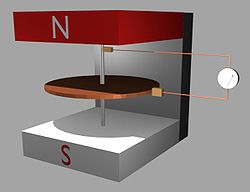Faraday disk generator
Autor/Urheber:
Émile Alglave
Größe:
1920 x 1500 Pixel (1373930 Bytes)
Beschreibung:
Drawing of Faraday disk, the first
electromagnetic generator, invented by British scientist
Michael Faraday in 1831. The copper disk (D) rotated between the poles of a horseshoe shaped magnet (A), creating a potential difference between the axis and rim due to
Faraday's law of induction. If an electrical circuit such as a galvanometer was connected between the binding posts (B) and (B') the motion induced a radial flow of current in the disk, from the axle toward the edge. The current flows into the spring contact (m) sliding along the edge of the disk, out of binding post (B') through the external circuit to binding post (B) , and back into the disk through the axle. Turning it in the opposite direction reverses the direction of current. The caption also says that passing a current from a Bunsen cell (battery) through it would cause the disk to turn, making it function as an
electric motor. The labeled parts are given in the caption as:
- (A) inducing magnet
- (D) induced disk
- (B) binding-screw for current entering or exiting axis of disk
- (B') binding-screw for current entering or exiting circumference of disk
- (m) rubber (sliding spring contact) for edge of disk.
The caption describes it as 'Foucault's and Le Roux's apparatus' so this picture was not drawn from Faraday's original machine, but one owned by Faraday's contemporary French physicist Léon Foucault. The Faraday disk was an inefficient generator because counter-currents flowed back through regions of the disk outside the magnetic field. It was the first homopolar generator
Alterations to image: cropped out caption and list of parts.
Kommentar zur Lizenz:
Public domain - published in USA before 1923
Weitere Informationen zur Lizenz des Bildes finden Sie hier. Letzte Aktualisierung: Thu, 08 Aug 2024 08:48:09 GMT
Relevante Bilder
Relevante Artikel
Unipolarmaschine
Eine Unipolarmaschine ist eine elektrische Maschine in spezieller Ausführung zur Erzeugung eines hohen Gleichstroms mit niedriger Spannung. Die Besonderheit der Unipolarmaschine besteht darin, dass sie mit Hilfe von Unipolarinduktion direkt Gleichstrom generiert. Dagegen erzeugen Gleichstromgeneratoren in der Regel erst mit Hilfe von Kommutatoren einen (pulsierenden) Gleichstrom.
.. weiterlesen



